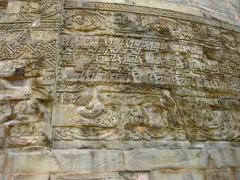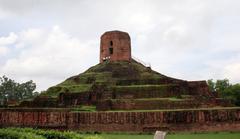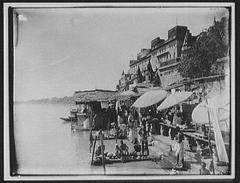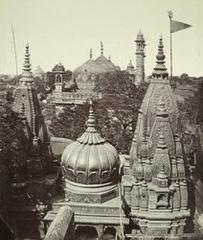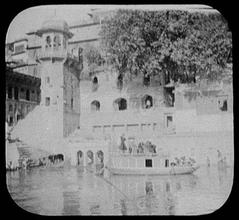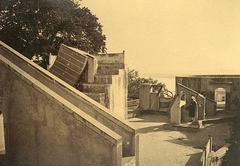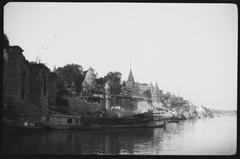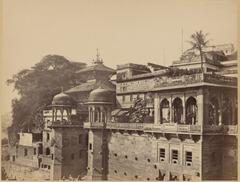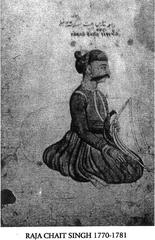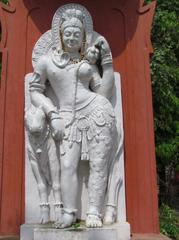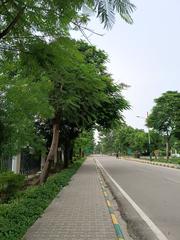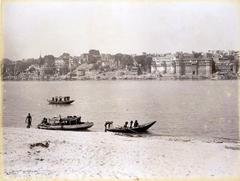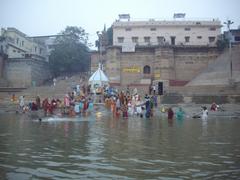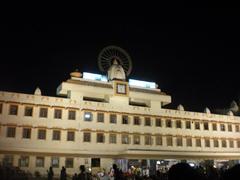
Dhamek Stupa Visiting Hours, Tickets, and Travel Guide in Varanasi
Date: 14/06/2025
Introduction: Gateway to Buddhist Heritage
Located in the sacred precincts of Sarnath near Varanasi, the Dhamek Stupa is a monumental symbol of Buddhist spirituality, history, and architectural brilliance. Revered as the site where Lord Buddha delivered his first sermon following enlightenment, it marks the “Turning of the Wheel of Dharma”—a pivotal event in the birth and spread of Buddhism. The stupa stands not only as a place of pilgrimage but also as a testament to centuries of artistic and cultural evolution, making it one of the must-see Varanasi historical sites. This detailed guide provides historical context, practical visitor information, ticketing, accessibility tips, cultural insights, and suggestions for nearby attractions to help you plan an enriching visit. (tusktravel.com; prepp.in; pilgrimsindia.com)
Early Origins and Historical Context
Sarnath holds an integral place in Buddhist tradition as the site where Siddhartha Gautama, after attaining enlightenment, delivered his first sermon to five disciples. This event, known as the Dharmachakra Pravartana, marks the foundation of the Buddhist sangha. The name “Dhamek” likely derives from “Dharmachakra,” reflecting this spiritual milestone. Archaeological evidence suggests that Sarnath was an active Buddhist center as early as the 4th century BCE, flourishing through the Mauryan era under Emperor Ashoka and later dynasties. (travelsetu.com; rishikeshdaytour.com; theprint.in)
Architectural Features and Evolution
Mauryan, Gupta, and Later Contributions
The earliest stupa is attributed to Emperor Ashoka (3rd century BCE), whose patronage was instrumental in spreading Buddhism and commissioning monuments at Sarnath. The Dhamek Stupa as seen today mainly dates to the Gupta period (5th–6th centuries CE), characterized by its massive cylindrical form—43.6 meters high and 28 meters in diameter. The lower stone section is adorned with intricate carvings of flora, fauna, and geometric patterns, while the upper brickwork remains unfinished. Archaeological layers reveal continuous occupation and construction through subsequent dynasties including the Shunga, Kushan, and Pala periods. (guidevaranasi.com; holyvoyages.com; localsamosa.com)
Symbolism and Artistic Heritage
The stupa’s structure symbolizes the Dharma wheel and the Buddhist cosmological axis. Gupta-era carvings—lotus medallions, diamonds, and bird motifs—showcase the artistic mastery of ancient India. Unlike many stupas, Dhamek currently lacks the harmika (railing) and chatra (umbrella), believed to have been lost over time. Surrounding the stupa are ruins of monasteries, smaller stupas, and the Ashoka Pillar with its iconic Lion Capital.
Archaeological Discoveries and Preservation
Systematic exploration began in the 19th century, unearthing the Ashoka Pillar and revealing the site’s multi-layered past. Later excavations uncovered sculptures, inscriptions, and relic caskets. The Archaeological Survey of India (ASI) oversees ongoing conservation using traditional methods and advanced monitoring to address weathering, pollution, and visitor impact. The site is protected under national heritage laws, and educational initiatives promote responsible tourism. (static.pib.gov.in; explorebuddham.com)
Visiting Dhamek Stupa: Hours, Tickets, and Facilities
Location & Accessibility
Dhamek Stupa is located in Sarnath, about 10 km northeast of Varanasi city center. It is easily accessible by taxi, auto-rickshaw, or public transport from Varanasi railway station or airport. The site is mostly wheelchair accessible, with paved walkways and basic amenities like restrooms and drinking water. (Agoda; Travejar; Gokshetra)
Visiting Hours
- Open daily: 6:00 am to 6:00 pm (some sources may list closing at 5:00 pm; confirm locally)
- Best time to visit: Early morning or late afternoon for a tranquil experience and optimal lighting
Tickets and Entry Fees
- Indian citizens and SAARC/BIMSTEC visitors: ₹5 per person
- Foreign nationals: ₹100 per person (some sources report INR 300 or 500 for Sarnath Archaeological Complex; check at entry)
- Children under 15: Free
- Video camera fee: ₹25 (if applicable)
Tickets are available at the entrance; online booking is generally unavailable. (Namaste India Trip; Tour My India)
Facilities & Amenities
- Clean restrooms near entrance
- Drinking water stations
- Wheelchair access to main walkways (some archaeological areas may be uneven)
- Local eateries and tea stalls outside the park
- Souvenir shops selling Buddhist crafts and books
- Authorized local guides available for a nominal fee
What to See and Do
- Circumambulation: Walk clockwise around the stupa for spiritual merit
- Photography: Permitted; seek permission before photographing monks or devotees
- Guided tours: Available at the entrance, providing cultural and historical context
- Nearby attractions:
- Ashoka Pillar: Home to the Lion Capital, India’s national emblem
- Mulagandha Kuti Vihar: Modern Buddhist temple with murals
- Sarnath Archaeological Museum: Houses relics and ancient sculptures
- Chaukhandi Stupa: Marks Buddha’s meeting with his disciples
- Deer Park: Site of the first sermon
Cultural and Religious Importance
Pilgrimage and Rituals
Dhamek Stupa is a major pilgrimage destination for Buddhists globally, especially from Thailand, Japan, Sri Lanka, Myanmar, and Tibet. Pilgrims circumambulate the stupa, chant, meditate, and make offerings. The site is particularly vibrant during festivals such as:
- Buddha Purnima (Vesak): Celebrating Buddha’s birth, enlightenment, and Mahaparinirvana
- Dharma Chakra Pravartan Day: Marking Buddha’s first sermon
- Magh Mela: Major religious gathering in January–February
Daily prayers and offerings occur at dawn and dusk, creating an atmosphere of devotion and peace. (holidify.com; casualwalker.com)
Cross-Cultural Legacy
Sarnath also holds significance for Jains and is enriched by its proximity to Varanasi, a major Hindu pilgrimage city. International monasteries and the Sarnath Museum underscore its ongoing role as a center for interfaith dialogue and cultural exchange. (tourismquest.com)
Best Time to Visit and Travel Tips
- Ideal months: October to March (pleasant weather, 10°C–25°C)
- Avoid: March–June (hot, up to 45°C) and July–September (monsoon)
- Festival periods: Expect crowds but vibrant cultural experiences
Visitor Tips
- Dress modestly; light, comfortable clothing recommended
- Wear sturdy shoes for uneven paths
- Carry water, sunscreen, and a hat
- Cash in small denominations is useful
- Respect local customs and maintain silence in prayer areas
Suggested Itinerary
- 8:00 am: Arrive in Sarnath, breakfast at a local eatery
- 9:00 am: Explore Dhamek Stupa and surroundings
- 10:00 am: Visit Mulagandha Kuti Vihar and Ashoka Pillar
- 11:00 am: Tour Sarnath Archaeological Museum
- 12:00 pm: Optional: visit Chaukhandi Stupa or Deer Park
Frequently Asked Questions (FAQs)
Q: What are the Dhamek Stupa visiting hours?
A: Daily from 6:00 am to 6:00 pm (verify locally for seasonal variations).
Q: How much are tickets?
A: ₹5 for Indian/SAARC/BIMSTEC visitors, ₹100–₹500 for foreign nationals, free for children under 15.
Q: Is photography allowed?
A: Yes, but be respectful, especially during rituals. Drones/tripods require permission.
Q: Are guided tours available?
A: Yes, local guides can be hired at the entrance.
Q: Is the site accessible for visitors with disabilities?
A: Main walkways are accessible; some archaeological areas may pose challenges.
Q: What other attractions are nearby?
A: Ashoka Pillar, Sarnath Museum, Mulagandha Kuti Vihar, Chaukhandi Stupa, Deer Park.
Visuals and Interactive Resources
- High-resolution images of Dhamek Stupa’s carvings and grounds
- Interactive map of Sarnath’s historical sites (with alt text: “Map of Dhamek Stupa location in Sarnath near Varanasi”)
- Infographics summarizing visiting hours and ticket prices
Conclusion
The Dhamek Stupa is a profound symbol of Buddhist heritage and Indian cultural legacy. Its towering architecture, layered history, and living spiritual traditions make it an essential stop for pilgrims, history buffs, and travelers alike. Plan your visit with the latest information on hours and ticketing, explore nearby attractions, and immerse yourself in the peaceful atmosphere of Sarnath. For a deeper experience, consider guided tours and participate respectfully in rituals and festivals.
Ready to explore more? Download the Audiala app for personalized travel guides, follow us on social media for updates, and check our related articles on Varanasi’s heritage sites!
Summary Table: Key Visitor Information
| Feature | Details |
|---|---|
| Hours | 6:00 am – 6:00 pm daily |
| Tickets | ₹5 Indian/SAARC, ₹100–₹500 foreigners, <15 yrs free |
| Accessibility | Wheelchair access to main areas; some uneven walkways |
| Best time | October–March |
| Guided Tours | Available at the entrance |
| Facilities | Restrooms, drinking water, souvenir shops, food stalls |
| Nearby Sites | Ashoka Pillar, Sarnath Museum, Mulagandha Kuti Vihar |
Sources and Further Reading
This guide draws on the following authoritative resources for accuracy and up-to-date information:
- Dhamek Stupa Visiting Hours, Tickets & Historical Guide to Sarnath’s Iconic Buddhist Monument (tusktravel.com)
- Complete Guide to Dhamek Stupa: Religious Significance, Festivals, and Visitor Information (prepp.in)
- Dhamek Stupa Visiting Hours, Tickets, and Historical Guide to Varanasi’s Iconic Buddhist Monument (pilgrimsindia.com)
- Dhamek Stupa Visiting Hours, Tickets, and Travel Guide to Varanasi Historical Sites (Agoda)
- What happened at Sarnath in the 300 years between Buddha and Ashoka? Archaeology has clues (theprint.in)
- Exploring Sarnath Heritage (localsamosa.com)
